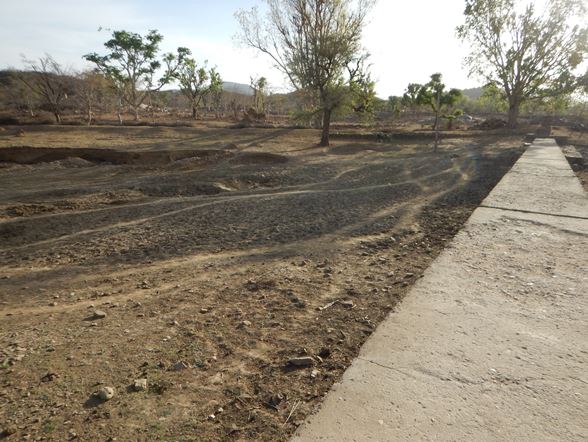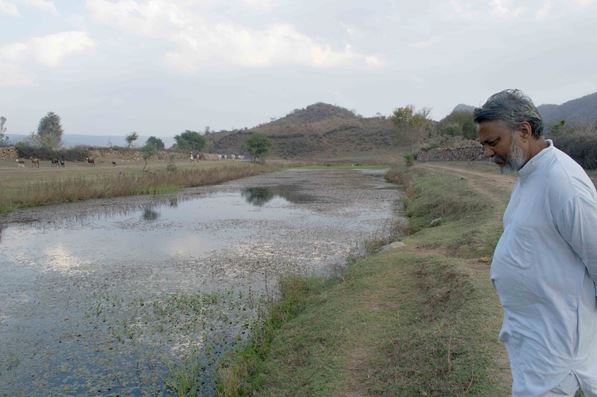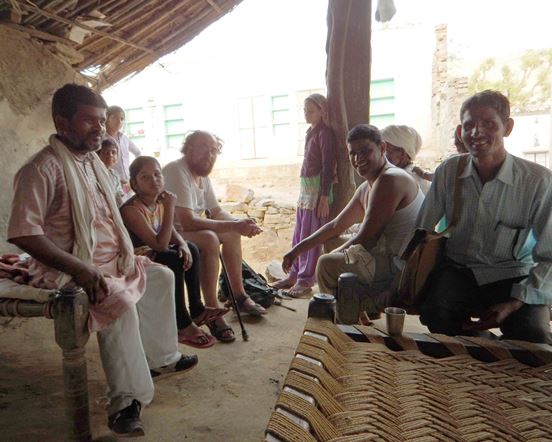
retained by an anicut (low flat dam) near Kalid village, in drought-
stricken north Rajasthan (© Mark Everard, April 2016).
Over the course of the eighteenth, nineteenth and twentieth centuries, a sequence of droughts have resulted in tens of millions of deaths across India. These devastating droughts will recur – indeed are happening today – and will be ever more problematic with a booming population, intensifying land uses and increasing climatic instability.
Agricultural practices in India are dependent on climatic conditions that vary across the subcontinent. The transit of the southwestern monsoon brings moisture episodically from the Arabian Sea to western and northern India between July and September, whilst the northwestern monsoon sporadically waters the east coast between October and December from cyclones drifting in and dumping water evaporated from the Bay of Bengal.
Monsoon rainfall is often highly localised in both space and time. Virtually all of the yearly precipitation from the southwestern monsoon falls intensely to ground in just a few days, spread across a narrow six-week window. Monsoon rains are also becoming increasingly unpredictable under a changing climate.
This annual cycle of ‘feast and famine’ has spurred ingenious rainwater harvesting methods across the subcontinent. Adapted to local topography, geology, climatic variability and cultural context, India is a land of myriad clever innovations in water capture and storage.

Singh, inspects a wildlife-rich, multi-use water body recharging
groundwater. This immediately downstream of the same anicut near
Kalid village, north Rajasthan (© Mark Everard, March 2013).
In my previous article Cultural co-benefits of community-based regeneration in north Rajasthan, I outlined how restoration of water capture methods in one area of Rajasthan State was regenerating ecosystems and the socio-economic welfare of communities that had for too long been suffering cycles of decline in the face of state centralisation and consequent dispossession of water management.
Locally adapted techniques – tank systems often known as eris in Tamil Nadu, johadi and chaukas in Rajasthan, and many more locally adapted rainwater harvesting systems besides – intercept often intense surface water run-off generated during monsoon deluges, storing it and, importantly, enabling it to percolate into the ground. Percolation not only increases soil moisture for cropping but also recharges the water table, making water available in wells for year-round access. Underground storage is important in arid and semi-arid regions experiencing high evaporation rates, as surface soils protect the underground resource.
Whilst these centuries-old, locally attuned innovations have enabled Indian communities to prosper even in habitats as severe as Rajasthan’s Thar Desert, policy shifts in the late-colonial and post-independence eras have focused more on state centralisation of ownership and management of water. This situation is intensified by the introduction of deep tube wells and energised pumping, proliferating since the 1990s. Pumping by farmers is often supported by generous state energy subsidies to boost agricultural production, privatisation of benefits effectively breaking links with community stewardship and particularly the balancing of recharge and exploitation. Dams and water transfer schemes compound this situation as, whilst securing water supplies for major cities, industries and intensive agricultural regions, flows of water serving India’s ecosystems and the majority of its people become constrained. This serves India poorly and in three principal ways.
- Firstly, damming rivers creates major asymmetries in benefits and costs. Intensive users of water and hydropower benefit, whilst huge numbers of people depending on the flows and services of rivers – for water abstracted for a range of purposes, fertilisation of grazing and cropping lands on floodplains, habitat maintenance and spiritual sites, migratory fish and other species, disease regulation under naturally variable flow regimes, and many more factors besides – see only an erosion of wellbeing. (An analysis of these distributional impacts in a real Indian case study can be found in The proposed Pancheshwar Dam: A preliminary ecosystem services assessment of likely outcomes.)
- Secondly, across wider landscapes there are reduced incentives for maintenance of rainwater harvesting structures and associated social infrastructure by communities, as the policy and subsidy environment favours pumping of ever-receding, now increasingly contaminated, groundwater for private benefit.
- Thirdly, the wider policy environment fails to balance increasingly efficient exploitation with resource regeneration, seriously undermining resource availability and the resilience of the whole socio-environmental system.

village, north Rajasthan, to discuss community water management
issues (© Mark Everard, April 2016)
Highly significantly, India is experiencing widespread abandonment of the community infrastructure essential to plan, create and maintain the communally owned rainwater harvesting structures constituting the roots of India’s water security.
Centuries of innovation and its associated wealth of traditional knowledge are being set aside and lost in pursuit of short-term gains achieved on the back ‘heavy engineering’, input-intensive – albeit increasingly efficient – exploitation of depleting resources. This is why the restoration of community-based regeneration of water, ecosystems and linked socio-economic systems is so important – as reported in my earlier article but also the subject of other ongoing research strands under the IWSN.
The goal of this research is to influence the Indian policy environment, at local, state and national levels, to emphasise by positive example the importance of reprioritising recharge of water in landscapes, and with it to restore much of the resilience lost through privatisation, diversion and other narrowly exploitation-focused management approaches.
India’s cyclic history of devastating droughts, as well as periodic declines in agricultural output, are correlated closely with El Niño-Southern Oscillation (ENSO) events. This alone provides compelling evidence of the need to recognise, reinterpret within contemporary conditions, and reincorporate into the policy environment, the long history of regionally adapted water resource recharge methods. Devolution of management to local levels, passing power and consent from the centre to community level, is a priority as community-level organisation is as important for successful implementation as the technical rainwater harvesting solutions themselves.
If more stimulus for political leadership was required, India’s current deep drought is a further ‘wake up’ call. Today, India is suffering a severe, so-called ‘killer’ heatwave contributing to the worst drought in decades and leaving the rural population struggling to survive. The Indian government estimates up to 330 million people could currently be affected by dry climatic conditions. There is hope that relief from the current deep drought may follow the arrival of the monsoon in mid-June, with above-average rainfall predicted due to the impending La Nina weather pattern. However, groundwater levels are now so depleted that even a good monsoon may be insufficient to compensate. Today, before the much hoped for rains are due to fall, armed men stand guard over residual water resources in some places whilst crops are failing in fields across the nation.
In May 2010, the Indian Prime Minister’s Climate Council signalled the need to reform water management sustainably, beyond simple supply-demand. The current Prime Minister, Mr Narendra Modi, has reiterated this call in the light of current water stresses. At state level, Rajasthan’s Jal-Swavlamban (water stewardship) programme highlights the need for an integrated approach less reliant of central government-controlled, big technology solutions. So there are open doors at a political level, even if the reality deduced from speaking to people on the ground is that there is no political appetite for withdrawing generous subsidies to farmers for pumping of depleting groundwater, perceived as a vote-loser. Tarun Bharat Sangh, a Rajasthan-based NGO promoting community-based recharge of groundwater, with whom IWSN has been working, has a scheduled meeting with Mr Modi and also senior representatives of the opposition Congress party, petitioning for a Water Recharge Act. I am applying for funding for a programme of co-learning with NGO and academic partners to provide an evidence base and run workshops involving policy-makers to further influence this agenda.
Meanwhile, we all keep our fingers crossed for a wet monsoon in June to relieve the real suffering of people across India. But also we do what we can to encourage the restoration of ecosystem vitality and services, though promotion of the solid case for recharge of groundwater from monsoon run-off as perhaps the wisest and most strategic investment in India’s future resilience.
